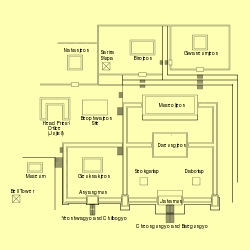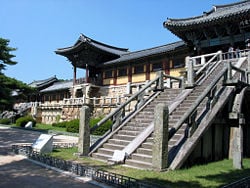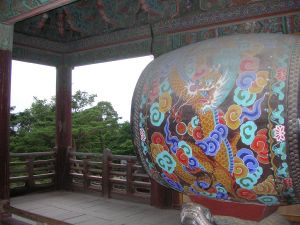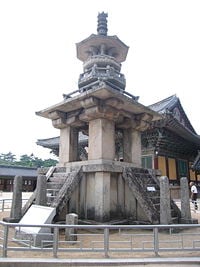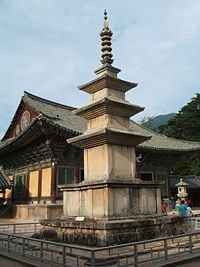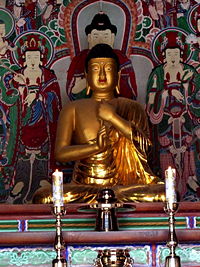Bulguksa
| Bulguksa | ||||||||
|---|---|---|---|---|---|---|---|---|
 | ||||||||
| Korean name | ||||||||
|
| Seokguram Grotto and Bulguksa Temple* | |
|---|---|
| UNESCO World Heritage Site | |
| State Party | |
| Type | Cultural |
| Criteria | i, iv |
| Reference | 736 |
| Region** | Asia-Pacific |
| Inscription history | |
| Inscription | 1995 (19th Session) |
| * Name as inscribed on World Heritage List. ** Region as classified by UNESCO. | |
Bulguksa, one of Korea's largest and most often visited temples, sits on the side of T'oham-san (T'oham mountain) directly east of Kyongju, in Gyeongsang province. If legends written during the Yi Dyansty are correct, the temple is one of the oldest, if not the oldest, surviving temples in Korea.
The temple area is the home of six Korean National Treasures and one treasure, including Dabotap and Seokgatap stone pagodas, Cheongun-gyo (Blue Cloud Bridge), and two gilt-bronze statutes of Buddha. The temple is classified as Historic and Scenic Site No. 1 by the South Korean government, an honor fitting to the stature of the religious and cultural site.[1] In 1995, Bulguksa was added to the UNESCO World Heritage List together with the Seokguram Grotto, which lies four kilometers to the east.
Bulguksa is recognized as a masterpiece of the golden age of Buddhist architecture and art in the Unified Silla Dynasty. Currently (2007) the temple serves as the head temple, 11th district, for the Jogye Order of Korean Buddhism.
History
Beopheung of Silla|King Beopheung originally constructed a smaller temple, called Hwaom-popnyu-sa, on this site in 528. Beopheung had the temple constructed for his queen as a place to pray for Silla's peace and prosperity. That small temple highlighted the influence of Buddhism in Silla and foretold the profound influence that Buddhism would have in the Unified Silla Dynasty.
Two hundred years later during the reign of King Kyongdok, Prime Minister Gim Daeseong expanded the small temple to its current size and grandeur in 774, renaming the site Bulguksa, translated variously "Buddhist Country Temple" or Temple of the Buddha Land. The Silla royal court completed the building in 774, after Gim's death, and given its current name Bulguksa.
Fascinating legends surround the life of Prime Minister Gim.[2] During his first life, he lived an extremely poor life with his widowed mother. He had a big head and flat forehead; hence he received the nickname "Big Wall" (Daeseong). Legend notes poor Daeseong as an honest and faithful disciple of Buddhism. After his death, Daeseong experienced rebirth into the family of Prime Minister, Kim Mun-yang. They received a prophesy of Daeseong's by a mysterious voice from heaven. The characters for Daesong were written in gold on his palm at birth.
As Daesong grew into manhood, he received the inspiration to build the marveleous memorial in honor of his first and second parents. He designed and constructed Bulguksa in honor of the parents of his second birth, the Prime Minister and his wife. He built Sokuram shrine nearby to honor his first mother. Although the legends strike may strike us as fantastic, any one visting the memorials will experience a sense of awe beholding the magnificence of the artistry.
The temple was renovated during the Goryeo Dynasty and the early Joseon Dynasty. During the Japanese invasions between 1592 and 1598, the wooden buildings were burned to the ground. After 1604, reconstruction and expansion of Bulguksa started, followed by about 40 renovations until 1805. During the Japanese occupation of 1910-1945, the Japanese conducted a restoration, but there are no records of the work done, and known treasures disappeared during this time.
After World War II and the Korean War, a partial restoration was conducted in 1966. Upon an extensive archeological investigation, major restoration was conducted between 1969 and 1973 by the order of President Park Chung Hee, bringing Bulguksa to its current form. The famous stone structures are preserved from the original Silla construction.
At the peak of Bulguksa's glory, eighty wooden buildings graced the site, ten times more than today. Even with the diminished size of Bulgaksa, the visitor will find themselves awe struck by the beauty and grandeur of the temple architecture. For that reason, the South Korean government designated Bulgaksa Historic and Scenic Site #1.
The Entrance to Buddha Country
Sokkye-mun, two stone staircases and gates, (National treasures of South Korea|National Treasure No. 22 and No. 23) serve as the traditional entrances to the temple grounds. These two double level bridges rise and enter the 100 meter stone wall. The bridges have been restored using the original stone blocks. As the pilgrim mounted the "Blue Cloud Bridge" he symbolically left the world of suffering and entered "The Buddha Country," or "Bulguk."
The larger bridge stairway Baegungyo (White Cloud Bridge, 백운교) (National treasures of South Korea|National Treasure No. 23) is 33 steps high, corresponding to the 33 steps to enlightenment terminating at the gate of Jahamun (Mauve Mist Gate 자하문)which leads to Sakyamuni Hall. Baegungyo (White Cloud Bridge) is 5.4 meters and has 16 steps. One long single piece of granite is set down the center of each staired section. The lower portion, Cheongungyo (Blue Cloud Bridge, 청운교)is 6.3 meters long and has 17 steps with an arch eight feet wide and twelve feet high. There are thirteen stones spanning the larger arch.[3] Under Cheongungyo stairway a small fish pond representing the pure land of Buddha or Western Paradise of the Amit'a world once sat.
The second bridge stairway, (National treasures of South Korea|National Treasure No. 22) sits to the left of the larger stairway. Seventeen steps lead the pilgrim through Anyangmun(Peace Enhancing Gate, 안양문), the gate at the top of the stairs, and into the temple Geuknakjeon (the Hall of the Pure Land) dedicated to the Amit'a Buddha (National treasures of South Korea|National Treasure No. 27). Like its bigger conterpart, this bridge stairway has a higher and lower section. The lower flight of steps, Yeonhwangyo (Lotus Flower Bridge 연화교), and the upper flight of steps, Chilbogyo (Seven Treasures Bridge 칠보교) has a width of approximately 3 meters.[4] The Lotus Flower Bridge is known for its delicate carvings of Lotus Flowers on each step but these have faded with the weight of many pilgrims. The arch underneath Yeonhwagyo is approximately 1 meters wide and 2 meters high. Use of the two bridge stairway entrances has been prohibited since restoration of in 1973.
These pair of bridges share the 45 degree incline, arch underneath, and the combination bridge/staircase design of their brother bridges. Today, visitors are restricted from walking on the bridge.
The Walking Corridor and Corner Structures
Haengnang, Chongru, and Kyongru. Surrounding the Geuknakjeon and Daeungjeon temple compounds is Haengnang (Walking Corridor), or a roofed corridor open the the courtyards while closed to the outside. The restoration of the Walking Corridor was completed in 1973. 130 pillars support the Haengnang around the larger Geuknakjeon temple while seventy three pilliars support the Walking Corridor around the smaller Daeungjeon temple.
Chongru (Bell Pavilion) is located between the two bridge stair entrances. A large drum is set on the back of a turtle. Chongu sits on two stout wooden pillars, projecting over the retaining wall. A walk way is under the pavilion.
Kyongru is a corner pavilion that sits to the right of the larger stairway enterance. Destroyed by fire earlier, the pavilion has been rebuilt. A colorful, large wooden carp and elaborately designed gong are housed there.
The Stone Pagodas
Dabotap and Seokgatap stone pagodas. There are two pagodas on the temple site, which is unusual. The three-story Seokgatap (Sakyamuni Pagoda) which stands at 8.2 meters is a traditional Korean-style stone pagoda with simple lines and minimal detailing. Seokgatap is over 13 centuries old. Dabotap (Many Treasure Pagoda) is 10.4 meters tall and dedicated to the Many Treasures Buddha mentioned in the Lotus Sutra. In contrast to Seokgatap, Dabotap is known for its highly ornate structure. Its image is reproduced on the South Korean 10 South Korean won|won coin. Dabotap and Seokgatap are National treasures of South Korea|Korean National Treasures nos. 20 and 21, respectively.
The two famous stone pagodas, Dabotap and Seokgatap reside in the main courtyard of the Bulguksa Temple complex. They are, respectively, the twentieth and twenty-first national treasures of Korea and were designated on December 20, 1962.
The terrestrial and the two celestial abodes are manifested in Bulguksa: the terrestrial with a Shakyamuni Buddha Lotus Sutra, the celestial with Amitabha Buddha Avatamska Sutra. The large temple site is centred around two courts. One of the courts is centred on Daeungjeon, the hall which houses the Shakyamuni Buddha. The other is centred on Geuknakjeon, the hall of paradise where the Seven Treasure Bridge Chilbogyo is housed.
Daeungjeon (대웅전), the Hall of Great Enlightenment, is the main hall.[5] Dabotap and Seokgatap stand before this hall. The hall enshrines the Sakyamuni Buddha and was built in 681 CE.[5] Behind the main hall stands Museoljeon (무설전), the Hall of No Words.[5] This hall gets its name from the belief that Buddha's teachings could not be taught by mere words alone. It is one of the oldest buildings in the complex and was probably built in 670 CE.[5] The Gwaneumjeon (Avalokitesvara's Shrine, 관음전) houses an image of the Avalokitesvara, the Bodhisattva of Perfect Compassion, and stands at the highest point of the complex.[5] The Birojeon (Vairocana Buddha Hall, 비로전), which sits below the Gwaneumjeon, houses national treasure No.26 while the Geuknakjeon (Hall of Supreme Bliss, 극락전), standing near the main compound, houses the gilt-bronze buddha that is the national treasure No.27.[5]
Official treasures at Bulguksa
National Treasure No.26
Natioanl Treasure No.26 (Bulguksa geumdong birojana buljwasang), designated on December 20, 1962, is a seated gilt-bronze Vairocana Buddha statue at Bulguksa Temple.
The Buddha of Enlightenment is enshrined in the Birojeon. It is 1.77 meters in height and made from gilt-bronze. The head of the Buddha has an usnisa, a symbol of supreme wisdom. The head of the Buddha was made by fusing two shells to each other and the face is elongated and soft. The robes of the Buddha are highly detailed and the simulation of folded cloth rippling down from the shoulder to the lap is done with high skill. The hands of the Buddha are in a position, the right index finger covered by the left hand, that often is used to symbolize the Buddha of Enlightenment. The figure is estimated to be from the 9th century CE due to stylistic evidence, including the overly wide lap and the lack of tension in the depiction of the robes and face of the Buddha.
National Treasure No.27
The seated gilt-bronze Amitabha Buddha statue of Bulguksa Temple is National Treasure No.27. (Bulguksa geumdong amita yeoraejwasang) and was designated on December 20, 1962.
The Amitabha Buddha statute is 1.66 meters in height and enshrined in Geuknakjeon. This gilt-bronze statue was probably cast in the late eighth or early part of the ninth century and it shares the style of National Treasure No.26. The head of the statue is made by fixing two shell-like pieces together. The face has a distinctively aquiline nose. The Buddha has broad shoulders and strong chest while the large lap gives the figure a sense of proportional harmony and stability. The style of the robe seems to be more stylized and haphazard. The position of the left hand raised at shoulder-level palm forward and the right hand is placed at the lap. The style of the Buddha seems to follow an abstract and stylized tradition rather than a representation of realism.
Treasure No.61
This sarira pagoda (사리탑), or stupa, looks like a stone lantern. It stands 2.1 meters tall and is located at the left side of the front garden of Birojeon. The artifact was at one point taken to Japan in 1906 but was eventually returned. It is from the Goryeo Dynasty and shows the influence of Silla Dynasty art.
A sarira is a container for the relics or remains of famous priests or royalty. It is said that this sarira contained the remains of eight priests or a queen. The three main features of the piece are the foundation stone, the main body, and the ornamental top. The foundation is an octagonal stone decorated with carvings. Atop this foundation is a circular stone incised with louts motifs. The pillar supports of the main pody are carved with a cloud motif while the main pody is cylindrical and has four bas-reliefs of Buddha and bodhisattvas and are accompanied by flower motifs. The top of the pagoda has twelve sides which meet into a hexagonal shape.
Gallery
- Bulguksa 1.jpg
A garden at the temple complex.
See also
- List of Buddhist topics
- List of Korea-related topics
- Korean Buddhist temples
- Tourism in Gyeongju
ReferencesISBN links support NWE through referral fees
- ↑ Historic and Scenic Sites 1; Bulguksa Temple in Gyeongju. Cultural Heritage Administration.
- ↑ Adams, Edward B. 1979. "Kyongju Guide: Cultural Spirit of Silla in Korea". Seoul, Korea:Seoul International Tourist Publishing co. ASIN: B0006E0Y7O
- ↑ Middleton, Dorothy H. and William D. 1975. "Some Korean Journeys". Seoul, Korea:Royal Asiatic Society, Korea Branch LC Number: 77354470 //r92
- ↑ Bulguk-sa Temple - Treasures.
- ↑ 5.0 5.1 5.2 5.3 5.4 5.5 Bulguk-sa Temple - Structures.
- National Treasure No.23
- National Treasure No.22
- National Treasure No.26
- National Treasure No.27
- Treasure No.61
- Life in Korea: Bulguksa.
External links
- Official site
- Korean National Heritage Online: Bulguksa
- The Architecture and Skyscraper Community of Korea (English traslated)
Template:Buddhism2
Credits
New World Encyclopedia writers and editors rewrote and completed the Wikipedia article in accordance with New World Encyclopedia standards. This article abides by terms of the Creative Commons CC-by-sa 3.0 License (CC-by-sa), which may be used and disseminated with proper attribution. Credit is due under the terms of this license that can reference both the New World Encyclopedia contributors and the selfless volunteer contributors of the Wikimedia Foundation. To cite this article click here for a list of acceptable citing formats.The history of earlier contributions by wikipedians is accessible to researchers here:
The history of this article since it was imported to New World Encyclopedia:
Note: Some restrictions may apply to use of individual images which are separately licensed.
